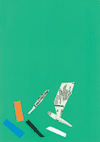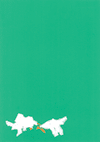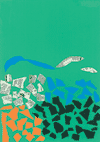| Approach: Independent |
Level:
Year 4
and year 8 |
|
| Focus:Students
can compose a picture by creating, selecting and assembling shapes,
colours and textures in ways that give expressive impact. |
Resources:
Video on laptop
computer. Per student:1 sets of 6 papers, 1 pair scissors,
1 gluestick, 1 base sheet. |
| Time:
40 mins
|
|
 |
5.3Mb |
|
|
|
Questions/instructions:
This activity uses
the computer.
Put one set of papers, a base sheet and a pair of scissors at each student’s
independent workspace. Do not put out glue sticks yet.
In this activity you are going to make a picture by cutting, tearing
and arranging different pieces of paper. Your picture is to show a couple
of birds fighting to get the few scraps of food. Try to imagine two
very excited and extremely hungry birds as they fight and battle to
get a share of the food scraps.
We’ll watch a video to help you think about what your birds might
look like — and how they will be behaving.
Click
the Bird Battle button.
Your birds don’t have to look the same as the ones you saw
in the video. You don’t even have to show the whole bodies
of the birds. Instead, you might choose to focus on the parts of
their bodies — like their hungry, screaming heads, their pushy
shoulders, grabby legs, flapping wings and ruffled feathers. You
may want to show hungry expressions, and how desperate they are
for food as they poke, flap, scratch and scrabble. |
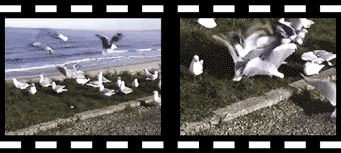
[No voiceover; sound of screaming seagulls only] |
Try to make your
birds interesting and active. Just think what they will look like —
how badly they are behaving — and the terrible screeching noises
they would be making as they rudely and roughly grab and snatch at the
food scraps. Remember to use your papers in interesting ways — by
cutting, tearing, overlapping and arranging. Don’t make too many
little pieces of paper or it will take too long to stick them down. And
please don’t make any scenery — just the birds. Make them
as big as you can.
10 minutes before the end of this activity I will give you a glue stick
so that you can glue your picture into place. You have 30 minutes
altogether to make your picture.
After 20 minutes give out the glue sticks and tell the students they have
10minutes to finish off.
Encourage students to use all of the available time.When 30 minutes is
up, prepare to collect in students’ work. |
| |
%
responses
2003 ('99) |
| y4
|
y8 |
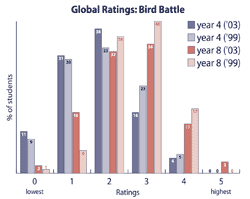 [click on graph
for enlargement]
[click on graph
for enlargement] |
Key
attributes: (0 low – 3 high) |
|
|
expressiveness:
image relevant to the task; expressiveness, fantasy, imagination |
1.35
(1.28) |
1.79
(1.85) |
composition:
unity;
balance but not necessarily symmetry |
1.41
(1.49) |
1.92
(2.04) |
detail:
finer features included;
variety of shapes;
use of textural and tonal contrast
(e.g. torn/cut, textured/plain, light/dark, narrow/wide,
delicate/bold) |
1.24 (1.32) |
1.65
(1.96) |
use
of media:
edge quality;
use of overlap, overlay, folding, crushing, 3-dimensionality |
1.15
(1.26) |
1.57
(1.80) |
Global
rating:
(0 low – 5 high) |
1.71
(1.84) |
2.49
(2.65) |
Commentary
In this trend task, the work produced by students in 2003 was compared
with a carefully selected sample of the work produced by students in 1999.
Both sets of work were assessed by the same team of teacher markers. Overall,
there was little difference in mean scores on analytic and global ratings
across the four-year period for year 4 and year 8 students respectively,
although some growth of skill from year 4 to year 8 was apparent in both
1999 and 2003. For example, the work of 16% of year 8 students compared
with 4% of year 4 students in 2003 was given a global rating of 4 or 5
on a six-point scale. The wide range of work produced by students showed
that most were able to make a good attempt at constructing visual images
with defined materials to depict a prescribed event (birds competing for
food).
|
BIRD
BATTLE EXEMPLARS –
Key criteria: expressive/imaginative, composition / space / shapes,
details, media skills.
[click
on pictures to enlarge] |
MID
RANGE EXEMPLARS:
The text offers possible answers to two diagnostic questions: What
can the student do? Where to next? |
 Here
our squabbling birds are shown as a tug-of-war between a neat matching
pair. Our attention is drawn to the white strip of food tugged between
their beaks. A common feature of mid-range work is that the drama
of the moment is reduced by a concern for symmetry and a standardized
symbol for “bird”. By paying attention to the differences
between individuals in both shape and movement, more could have
been expressed. Collage lends itself to exploration before sticking
down. Placement of each part on the page could have been explored
to suggest who might be the victor in the battle. Here
our squabbling birds are shown as a tug-of-war between a neat matching
pair. Our attention is drawn to the white strip of food tugged between
their beaks. A common feature of mid-range work is that the drama
of the moment is reduced by a concern for symmetry and a standardized
symbol for “bird”. By paying attention to the differences
between individuals in both shape and movement, more could have
been expressed. Collage lends itself to exploration before sticking
down. Placement of each part on the page could have been explored
to suggest who might be the victor in the battle. |
 |
 This
student has developed refreshingly unique symbols for “bird”,
capable of expressing rebellious defensiveness and haughty dominance
through movements emphasising leaning back and thrusting forward.
They have been identified through posture and colouring. The two
main characters are so caught up in their drama that the small morsel
of food seems temporarily forgotten. The wings hug the bodies and
the white eyes disappear in a loss of contrast when placed on light
coloured heads. More could have been made of including the wings
and eye glance into the drama. This
student has developed refreshingly unique symbols for “bird”,
capable of expressing rebellious defensiveness and haughty dominance
through movements emphasising leaning back and thrusting forward.
They have been identified through posture and colouring. The two
main characters are so caught up in their drama that the small morsel
of food seems temporarily forgotten. The wings hug the bodies and
the white eyes disappear in a loss of contrast when placed on light
coloured heads. More could have been made of including the wings
and eye glance into the drama. |
 |
 Big
bird, little hunched bird, minimalist food scrap. The use of feather,
beak, leg elements to build differences in the birds is effective
but becomes a little confusing when similar dark colours and shapes
are used for the bird’s body and leg. The student had access
to white paper as well but chose not to include this possibility
in the image. The characters are on stage but there is too much
intervening space to establish a squabble yet. Big
bird, little hunched bird, minimalist food scrap. The use of feather,
beak, leg elements to build differences in the birds is effective
but becomes a little confusing when similar dark colours and shapes
are used for the bird’s body and leg. The student had access
to white paper as well but chose not to include this possibility
in the image. The characters are on stage but there is too much
intervening space to establish a squabble yet. |
 |
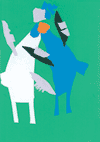 These
two wonderfully tangled creatures strain upwards, flap and wrestle
together to reach the food scraps. Their separate shapes take some
sorting out as both birds have a grey fringe of feathers on their
wings. The student could have chosen the newsprint texture to help
separate out the characters. Often students working in collage at
this level initially expect a cut scissor line to behave like a
drawn line – hence the fringing which works conceptually but
not visually. Most of the drama is happening in the wings and the
head, but we lack a clear symbol for moveable beaks because of the
view taken. The legs feel uninvolved at this stage. Perhaps the
student’s approach to cutting out the whole bird in one piece
was a strategic decision but this meant fewer options when it came
to moving parts around for dramatic effect. These
two wonderfully tangled creatures strain upwards, flap and wrestle
together to reach the food scraps. Their separate shapes take some
sorting out as both birds have a grey fringe of feathers on their
wings. The student could have chosen the newsprint texture to help
separate out the characters. Often students working in collage at
this level initially expect a cut scissor line to behave like a
drawn line – hence the fringing which works conceptually but
not visually. Most of the drama is happening in the wings and the
head, but we lack a clear symbol for moveable beaks because of the
view taken. The legs feel uninvolved at this stage. Perhaps the
student’s approach to cutting out the whole bird in one piece
was a strategic decision but this meant fewer options when it came
to moving parts around for dramatic effect. |
 |
 There
is no doubting the source of the squabble. The three food scraps
hold an immobile centre stage while beaks and webbed feet descend.
There is something heraldic about the symmetrically placed webbed
feet. They tend not to have any sense of threat by either shape
or placement. The student has chosen an interesting close–up
with shapes that have both torn and cut edges. But with close-up
comes the need for detail and a logic of the parts attaching themselves
outside the picture frame. Without those cues the viewer is left
slightly puzzled as to what bits belong to whom. There
is no doubting the source of the squabble. The three food scraps
hold an immobile centre stage while beaks and webbed feet descend.
There is something heraldic about the symmetrically placed webbed
feet. They tend not to have any sense of threat by either shape
or placement. The student has chosen an interesting close–up
with shapes that have both torn and cut edges. But with close-up
comes the need for detail and a logic of the parts attaching themselves
outside the picture frame. Without those cues the viewer is left
slightly puzzled as to what bits belong to whom. |
| LOW
RANGE EXEMPLARS: |
|
| HIGH
RANGE EXEMPLARS: |
|
|







